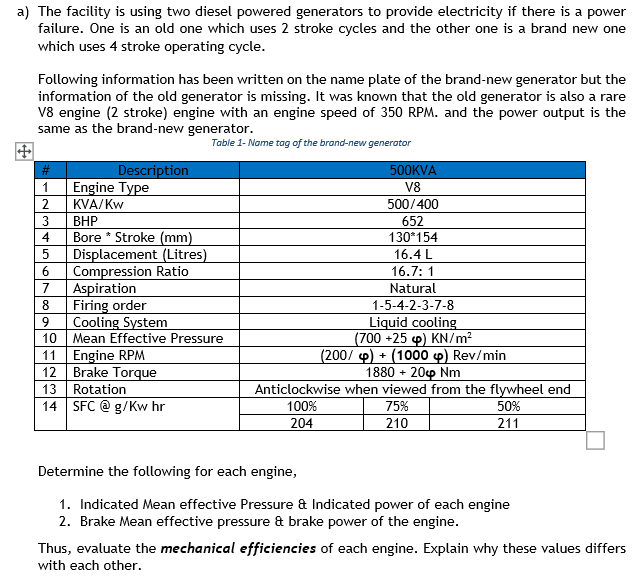a) The facility is using two diesel powered generators to provide electricity if there is a power failure. One is an old one which uses 2 stroke cycles and the other one is a brand new one which uses 4 stroke operating cycle. Following information has been written on the name plate of the brand-new generator but the information of the old generator is missing. It was known that the old generator is also a rare V8 engine (2 stroke) engine with an engine speed of 350 RPM. and the power output is the same as the brand-new generator. Table 1- Name tag of the brand-new generator # 1 2 3 4 Description Engine Type KVA/KW BHP Bore Stroke (mm) Displacement (Litres) Compression Ratio 6 7 Aspiration Firing order 8 9 Cooling System 10 Mean Effective Pressure 11 Engine RPM 12 Brake Torque 13 Rotation 14 SFC@g/Kw hr 500KVA V8 500/400 652 130*154 (200/ 16.4 L 16.7: 1 Natural 1-5-4-2-3-7-8 Liquid cooling (700 +25) KN/m² ) + (1000 ) Rev/min 1880 + 204 Nm Anticlockwise when viewed from the flywheel end 100% 75% 50% 204 210 211 Determine the following for each engine, 1. Indicated Mean effective Pressure & Indicated power of each engine 2. Brake Mean effective pressure & brake power of the engine. Thus, evaluate the mechanical efficiencies of each engine. Explain why these values differs with each other.
a) The facility is using two diesel powered generators to provide electricity if there is a power failure. One is an old one which uses 2 stroke cycles and the other one is a brand new one which uses 4 stroke operating cycle. Following information has been written on the name plate of the brand-new generator but the information of the old generator is missing. It was known that the old generator is also a rare V8 engine (2 stroke) engine with an engine speed of 350 RPM. and the power output is the same as the brand-new generator. Table 1- Name tag of the brand-new generator # 1 2 3 4 Description Engine Type KVA/KW BHP Bore Stroke (mm) Displacement (Litres) Compression Ratio 6 7 Aspiration Firing order 8 9 Cooling System 10 Mean Effective Pressure 11 Engine RPM 12 Brake Torque 13 Rotation 14 SFC@g/Kw hr 500KVA V8 500/400 652 130*154 (200/ 16.4 L 16.7: 1 Natural 1-5-4-2-3-7-8 Liquid cooling (700 +25) KN/m² ) + (1000 ) Rev/min 1880 + 204 Nm Anticlockwise when viewed from the flywheel end 100% 75% 50% 204 210 211 Determine the following for each engine, 1. Indicated Mean effective Pressure & Indicated power of each engine 2. Brake Mean effective pressure & brake power of the engine. Thus, evaluate the mechanical efficiencies of each engine. Explain why these values differs with each other.
Automotive Technology: A Systems Approach (MindTap Course List)
6th Edition
ISBN:9781133612315
Author:Jack Erjavec, Rob Thompson
Publisher:Jack Erjavec, Rob Thompson
Chapter9: Automotive Engine Designs And Diagnosis
Section: Chapter Questions
Problem 15RQ: Which of the following is an expression of how much of the heat formed during the combustion process...
Related questions
Question
the value of Φ is 0.2

Transcribed Image Text:a) The facility is using two diesel powered generators to provide electricity if there is a power
failure. One is an old one which uses 2 stroke cycles and the other one is a brand new one
which uses 4 stroke operating cycle.
Following information has been written on the name plate of the brand-new generator but the
information of the old generator is missing. It was known that the old generator is also a rare
V8 engine (2 stroke) engine with an engine speed of 350 RPM. and the power output is the
same as the brand-new generator.
Table 1- Name tag of the brand-new generator
#
1
2
3
Description
Engine Type
KVA/KW
BHP
4
Bore Stroke (mm)
5
Displacement (Litres)
6 Compression Ratio
7
Aspiration
Firing order
8
9 Cooling System
10 Mean Effective Pressure
11 Engine RPM
12 Brake Torque
13 Rotation
14 SFC @g/Kw hr
500KVA
V8
500/400
652
130*154
16.4 L
16.7: 1
(200/
Natural
1-5-4-2-3-7-8
Liquid cooling
(700 +25 p) KN/m²
) + (1000 ) Rev/min
1880 + 204 Nm
Anticlockwise when viewed from the flywheel end
100%
75%
204
210
50%
211
Determine the following for each engine,
1. Indicated Mean effective Pressure & Indicated power of each engine
2. Brake Mean effective pressure & brake power of the engine.
Thus, evaluate the mechanical efficiencies of each engine. Explain why these values differs
with each other.
Expert Solution
This question has been solved!
Explore an expertly crafted, step-by-step solution for a thorough understanding of key concepts.
Step by step
Solved in 3 steps

Recommended textbooks for you

Automotive Technology: A Systems Approach (MindTa…
Mechanical Engineering
ISBN:
9781133612315
Author:
Jack Erjavec, Rob Thompson
Publisher:
Cengage Learning

Automotive Technology: A Systems Approach (MindTa…
Mechanical Engineering
ISBN:
9781133612315
Author:
Jack Erjavec, Rob Thompson
Publisher:
Cengage Learning